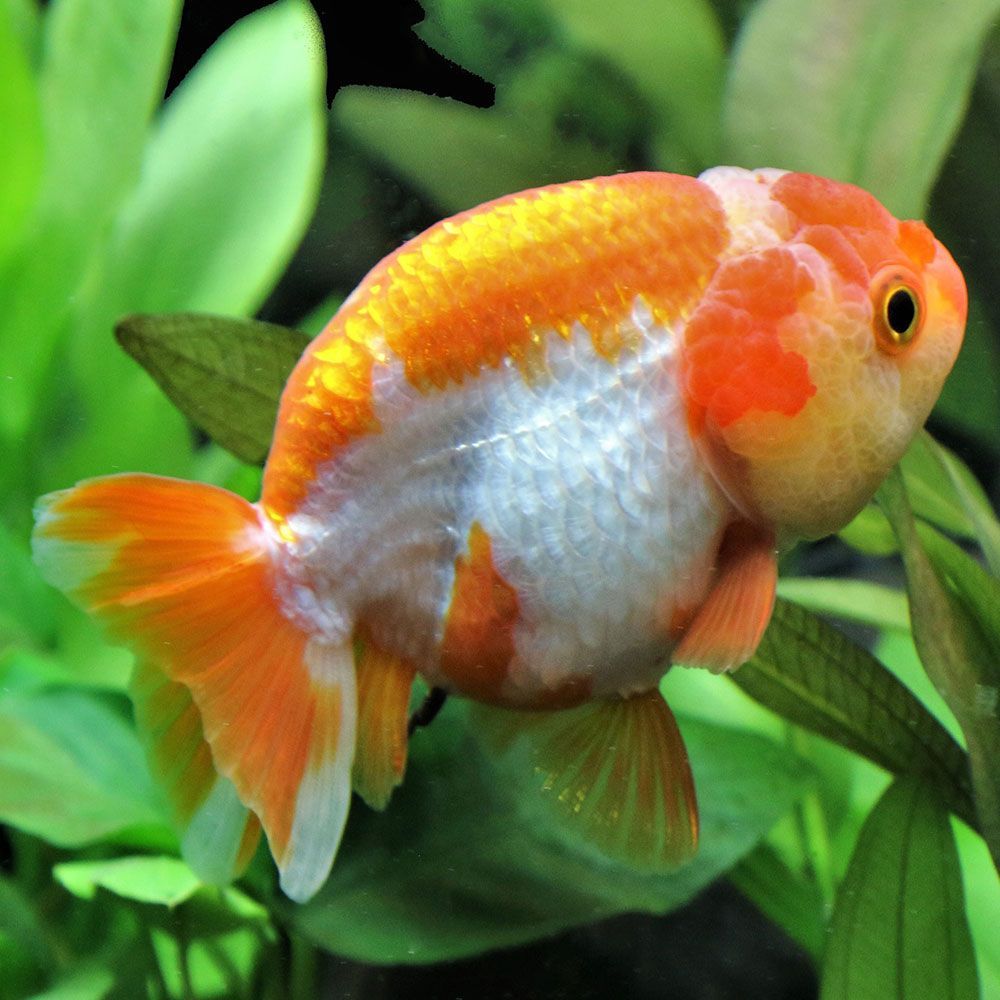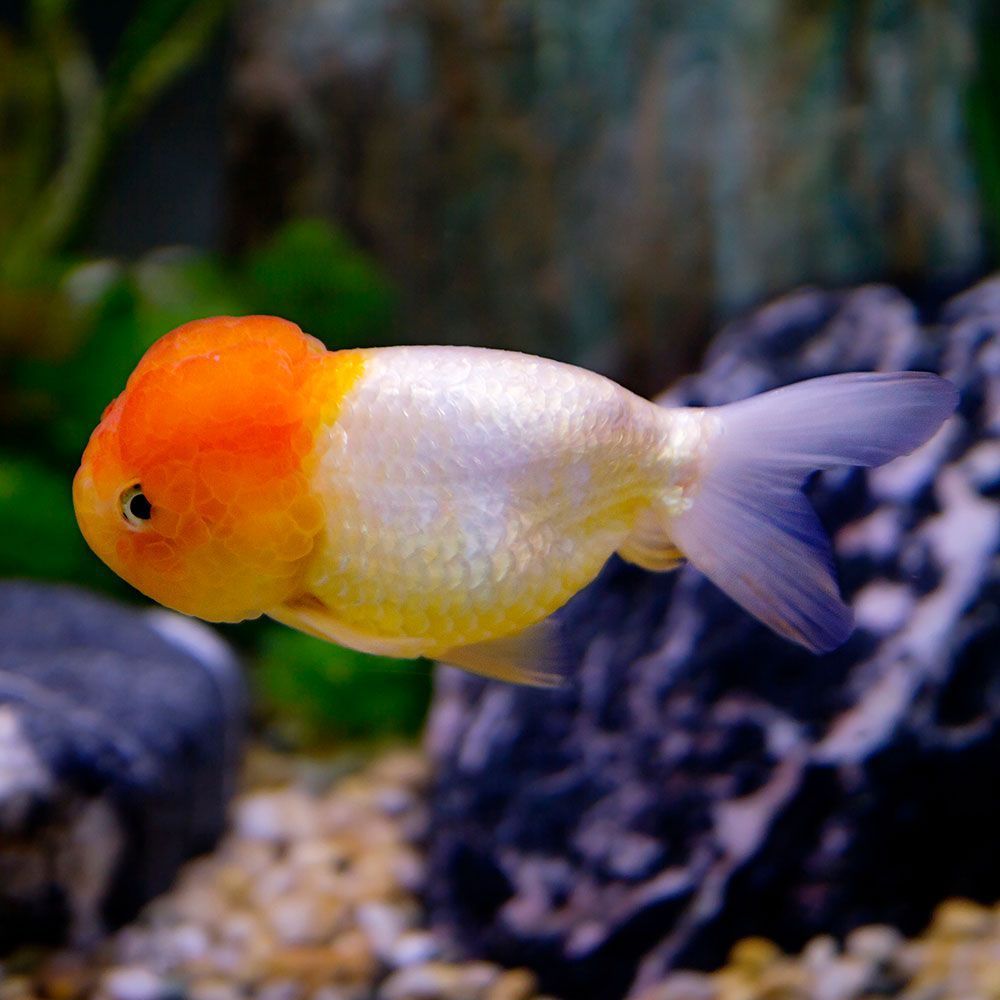Unlike other goldfish types, it doesn’t need a group of its own. So, if you have a space crunch, you can also keep only one!
Now, if you’re intrigued to know more, keep reading!
What is a Lionhead Goldfish?
The lionhead goldfish is a unique and cute freshwater fish. The fancy goldfish is suitable for both freshwater community and species-only tanks.
| Common Names | Lionhead goldfish, Shou-xing |
| Appearance | Commonly golden-orange with white patches or white with slight orange, round body tapering to tailfin, protruding scales, no dorsal fin, a rounded hump on the back, bumpy,raspberry-shaped wen |
| Size (Adult) | Usually 12-20 cm (5-8 inches), 25 cm (10 inches) with best care |
| Lifespan | Mostly 15 years, can live up to 20 years |
| Temperament | Peaceful |
| Tank Level | All levels |
| Care Level | Moderate |
| Minimum Tank Size | 20 gallons for one fish, add 10 gallons per extra fish, 50 gallons for a community |
| Tank Mates | Own type, slow-swimming goldfish varieties or gentle, non-aggressive community fish, some invertebrates |
What is the History of Lionhead Goldfish?
The lionhead goldfish was bred in China from Asian wild carp to resemble the mythical Chinese lion-dog.
It came to Japan in the 17th and 18th centuries, where the Japanese modified its appearance with a rounder back, different tail, and smaller head growth.
However, they still maintain the fish’s ancestral size and lifespan traits. The lionhead is a fancy variety similar to ryukin, oranda, and ranchu.
What makes Lionhead Goldfish Unique?
The lionhead goldfish lacks a dorsal fin, which is important for balance. So, it swims uniquely with slow, bobbing movements in search of food. It also has poor eyesight that can lead to occasional collisions with tank walls or decor.
Fun Fact: These fish are often confused with oranda goldfish due to their similarly shaped bodies and presence of hood. However, lionheads are typically rounder in shape compared to orandas.
How does Lionhead Goldfish look?

If you’re curious about the appearance and behavior of this species, let’s delve in deeper.
What is the Size of Lionhead Goldfish?
Lionhead Goldfish typically range from 12 to 20 centimeters (5 to 8 inches) in size. In my experience, some reach up to 25 centimeters (10 inches) in proper care, like other goldfish varieties.
What is the Color of Lionhead Goldfish?
The lionhead goldfish comes in diverse colors. While many are golden-orange with white patches, some are mostly white with a hint of orange. There are many other color variations, including blue, black, and calico.
What are the Key Features of Lionhead Goldfish?
This fish has a round, bulging body with a big belly and protruding metallic, nacreous, or matte scales. Its rounded shape tapers to the tailfin.
It lacks a dorsal fin, resulting in a rounded hump on their backs. There’s a double caudal fin and a double anal fin. The tailfin opens when it swims.
The goldfish also has a fleshy, bumpy, uneven raspberry-shaped cap, aka wen, around the head, which varies in size and texture from fish to fish.
How does Lionhead Goldfish Behave?
The lionhead goldfish is incredibly passive and non-aggressive, even during breeding. It is an ideal community fish, getting along well with other peaceful species. But it can also thrive alone.
It is a slow swimmer, often perceived as lazy. In reality, its slow movement is due to its poor swimming ability rather than laziness.
What is the Lifespan of Lionhead Goldfish?
On average, this fancy goldfish lives around 15 years. Some exceptional specimens reach up to 20 years. The lifespan is influenced by genetics, health, and the care received.
How to take care of Lionhead Goldfish?
Since care and breeding for lionhead goldfish share similarities with common goldfish, here we focus on parameters specific to this species. For comprehensive guidance, please refer to the detailed care guide before acquiring these fish.
If you’re enthusiastic about caring for this fish in your tank, let’s read about the proper care guidelines to ensure its well-being!
What is the Tank Size of Lionhead Goldfish?
For a single lionhead goldfish, a minimum 20-gallon tank is needed. For each additional fish, add 10 gallons. A 50-gallon tank is advisable for a community setup.
Some suggest keeping a single fish in a 10-gallon tank. But, in my understanding, it is too cramped and will have a high water flow, which is uncomfortable for the species.
Fish Care Tip: Keep only non-abrasive and safe decorations in your lionhead goldfish tank. Sharp or rough surfaces can harm these delicate fish.
What are the Food & Diet Requirements for Lionhead Goldfish?
The lionhead goldfish is omnivorous and prospers with a balanced approach of 50% protein-based food complemented by 50% plant-based foods. It’s safer to opt for freeze-dried foods over live ones to prevent potential parasites and bacterial infections.
Feed a balanced diet of the following:
- Brine shrimp
- Bloodworms
- Tubifex worms
- Mosquito larvae
- Daphnia
- Zucchini
- Fish flakes
- Goldfish-specific pellets
- Peas
- Romaine lettuce
The fish is a voracious eater but feed it only twice daily to prevent overeating and health issues.
Give extra time to locate and eat its food. Due to poor swimming abilities and impaired vision, it requires a bit more time.
Feeding Tip: Don’t feed the fish with only dry foods as that can lead to constipation, gastric troubles, and swim bladder issues. Incorporate occasional meaty foods or fresh vegetables into its diet to ease and prevent these problems.
Which Tank Mates should be Kept with Lionhead Goldfish?
Lionhead goldfish can thrive harmoniously in a community tank with peaceful, slow-swimming fish that won’t compete for food.
However, it’s equally content living alone. This makes it suitable for single-fish tanks, especially if space is limited.
Some compatible friends for this fish are other slow-swimming goldfish varieties or gentle, non-aggressive community fish, like:
- Banded corydoras
- Most loach species
- Rosy barbs
- Bubble eye goldfish
- Black moor goldfish
- Celestial goldfish
- Minnows
You can also choose invertebrates like:
- Danios
- Snails
- Shrimps
- Freshwater crabs
Which Tank Mates to Avoid keeping with Lionhead Goldfish?
Avoid housing them with the following kinds:
Fast swimmers (e.g.: common goldfish, comet goldfish, and shubunkin goldfish): Lionhead goldfish are slow and struggle to keep up with swift fish, leading to difficulties in feeding and potential stress.
Fin-nippers (e.g.: tiger barbs, serpae tetras, or bettas): The lionheads have delicate fins and are susceptible to injury, infection, or undue stress from such species.
Aggressive species (e.g.: cichlids or other territorial fish): They may harass and intimidate your goldfish, leading to stress and potential physical harm.
What are the Common Diseases for Lionhead Goldfish?
The lionhead goldfish are much more prone to illness and infection than other goldfish species. They need their tank water absolutely clean for optimum health.
Please go through the common goldfish article to know more about the diseases that can affect them and how to treat them in such cases.
Quick Tip: Ensure optimal tank hygiene and water quality to protect lionhead goldfish from infections and injuries, as neglect in this area can be life-threatening for them.
A word from FishInAquarium
The delightful lionhead goldfish have always been a hot topic among goldfish enthusiasts.
Since the fish is an opportunistic eater and rewarding to care for, aquarists have a gala time raising these slow-graceful swimmers.
We hope you found this article insightful and informative, and if you have any questions or need assistance, please don’t hesitate to reach out to our team.
Feel free to share this article with fellow aquarium enthusiasts to spread the joy of caring for these captivating species.


